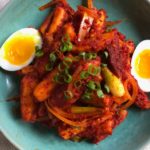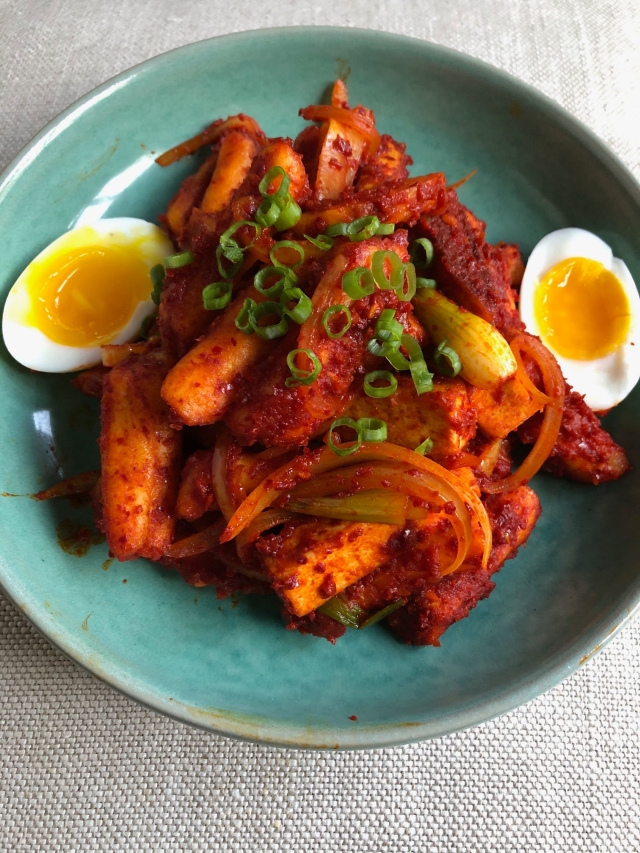
Many people fall in love with Korean food via meaty barbecue and various banchan. My first taste of Korean food was tteokbokki – thick, chewy soft chubby rods of rice cakes enrobed in a spicy-salty-slightly sweet red pepper sauce. During the mid-1990s, I was working as assistant director of the Asian Pacific American Student Services department at the University of Southern California. Our office conversations often included food from our various cultures.
One of my colleagues was a Korean-American woman named Jamie Kim. She was tall, thin and loved to eat. Koreatown was near USC and one day, she brought in a container of Korean spicy rice cakes, telling me to call them “tduk-boh-kee”. Jamie explained how it was a favorite of Koreans, especially young people and those who love to drink. It was noshing food. The spicy rice cakes were oddly addictive despite being just rice and spicy sauce. They were well seasoned, so I drank a lot of water.
Jamie gave me my first taste of Korean food and schooled me on things like how precise the Koreans are about cutting vegetables. Maintaining certain shapes and sizes is important, she resolutely said. And to serve Korean food, you want to use low, shallow, round vessels—expressions of Korean humbleness. Viet food didn’t have such strict rules, but I honored Jamie’s perspective because she was teaching me what was right and wrong in her culinary universe.
Sourcing Korean Ingredients
Since then, whenever I shop at a Korean market, I poke at the trays of round rice cakes sold near the cash registers. I’d never made tteokbokki until this weekend. (I know, the above photo looks like a face!)
To figure out the Korean spicy rice cakes, I needed help. I sought insight from two great cookbooks—Maangchi’s Real Korean Cooking, and Hooni Kim’s My Korea. I’d made recipes from both books in the past. Remember Maangchi’s delightful beef and tofu patties and Hooni’s incredible scallion pancakes? Those fab recipes didn’t require a trip to the Korean market like tteokbokki did.
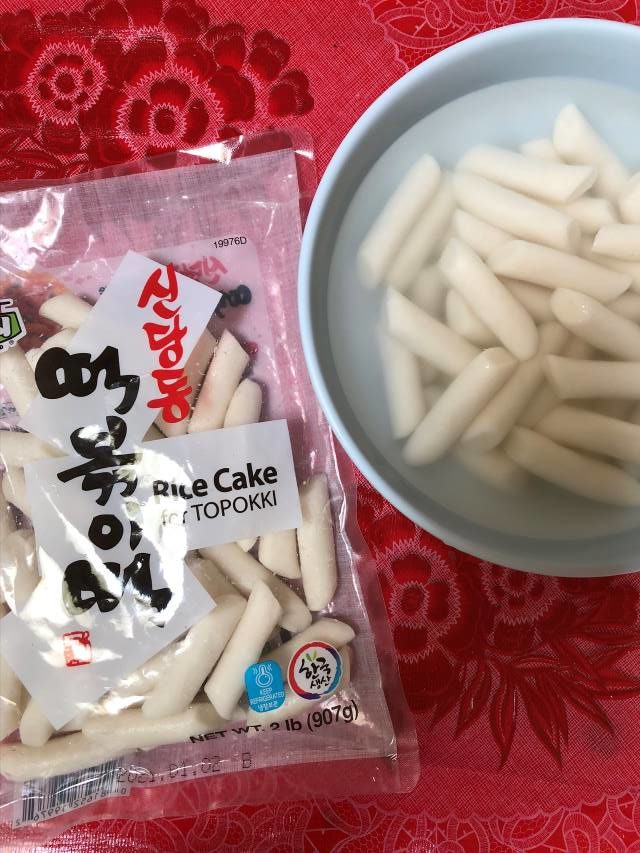
Because I needed the rice cakes, and a largish amount of gochugaru (coarsely ground red pepper), I shopped at small Korean market. I already had gochujang (red pepper paste), which you can get at supermarkets nowadays but there’s more selection at places like H Mart.
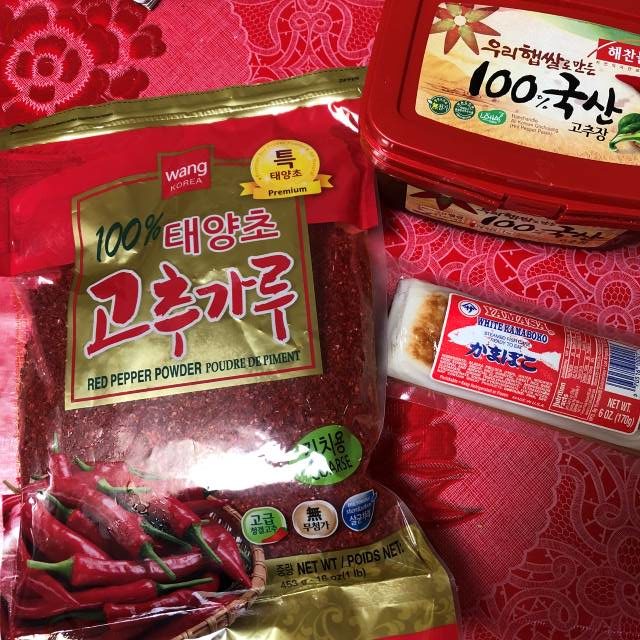
The only fish cakes I saw were the Japanese kind, so I picked up some. The rice cakes are sold frozen, though you may score fresh ones too. The frozen cakes require presoaking, Maangchi says, or they won’t cook up properly. Fresh ones don’t.
In any event, you’ll have to go to a Korean market.
Pan-fried Cakes and Soft-Boiled Egg Brilliance
Maangchi’s recipe was super simple, whereas Hooni’s was cheffy. I wanted cheffiness because he enticed with the idea of pan-frying the rice cakes. I combined both recipes to make the one here. After the first round of spicy rice cakes, Hooni’s approaching of frying the rice cakes and adding the sauce yielded hard-chewy results. I found that Maangchi was right: frozen rice cakes needed a good 10 minute cooking in liquid to soften to a decent chewy-tender state.
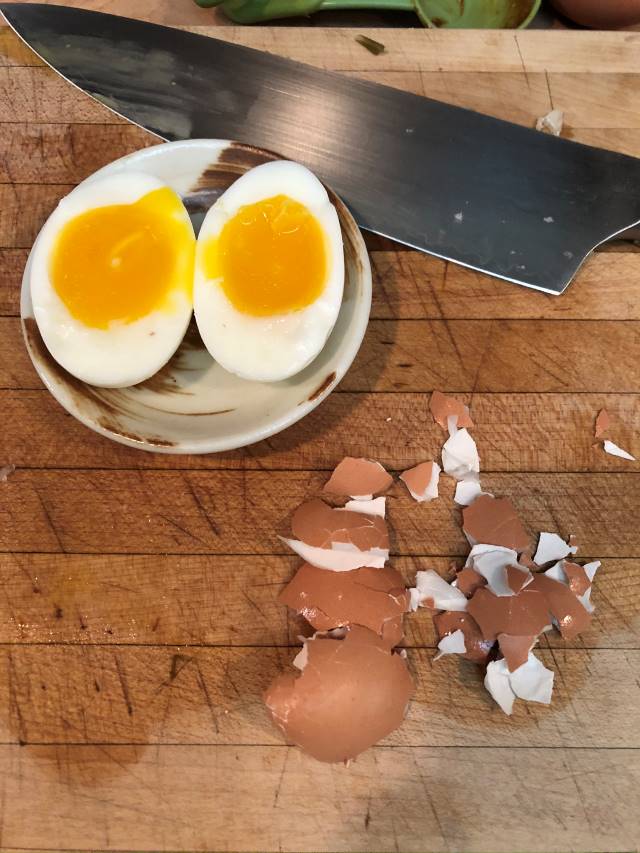
Boiled egg was what Maangchi called for, but Hooni also attracted me with a soft-boiled egg approach that I’ll be applying elsewhere. He boils the eggs in water seasoned with baking soda, vinegar, and salt to make them easier to peel. It worked brillianty. The eggs add a richness to the cakes.
I liked the technique so much that I made this quick video tip:
Broth, Sauce and Protein Tips
A concentrated dashi is typically used for Korean spicy rice cakes, and I tried it the first time out. It was good, but when I read Maangchi’s recipe headnote stating that canned chicken broth was a decent substitute, I made the swap. Adding fish sauce makes up for the lack of dried fish in the broth. It’s my cheat.
If you use dashi, double the amounts called for below and boil it to reduce it by half. Then use it for the sauce and cooking up the rice cakes.
Want to make this vegan or vegetarian? Make dashi with kombu and dried shiitake mushroom. Or, use a vegetable broth or brew stock yourself. Vegan cooks should omit the egg.
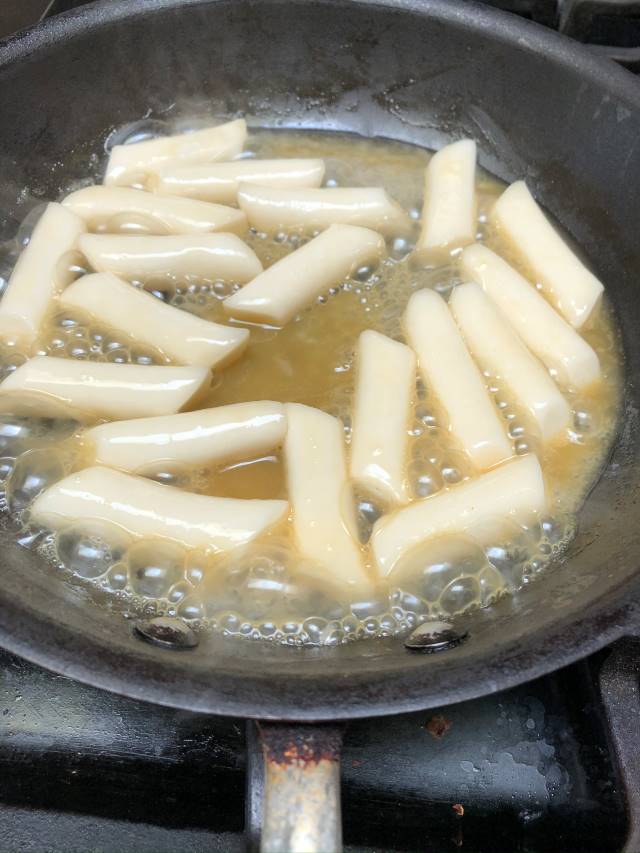
The rice cakes are often accentuated with fish cakes but if you can’t find that ingredient, extra-firm tofu is great. Korean tofu is firmer than other kinds of tofu so pick up a tub while you’re shopping for the other ingredients.
The sauce below is my adapted version of Hooni’s recipe in My Korea. He called a lot more ground pepper but I have stuff that’s on the spicy side so I use less. Let your palate and ingredients guide you; you can always add more pepper to intensify or splash in water to dilute. The sauce stores well in the fridge for days so you can make tteokbokki whenever you like.
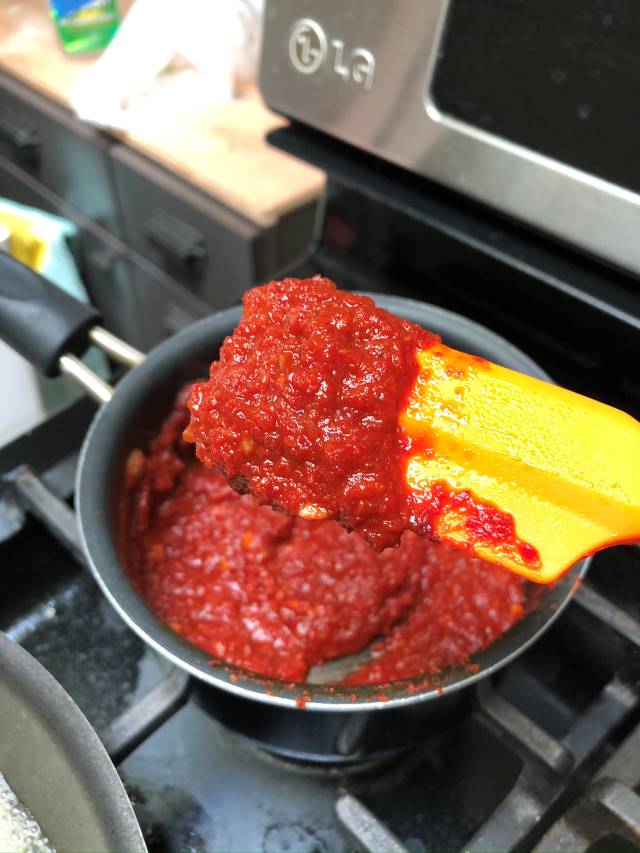
I own over 1,000 cookbooks and when I’m looking to craft something unfamiliar, I look to solid works like those of Maangchi and Hooni. They’re great guides for success.
Korean Spicy Rice Cakes
Ingredients
- 8 ounces Korean round frozen rice cakes, precut as 2-inch lengths, thawed
- 1 or 2 large egg
- Fine sea salt
- 1 teaspoon baking soda
- 1 tablespoon vinegar, any kind
- 1 large clove garlic
- 1 small yellow or red onion
- 2 medium, or 1 large green onion
- 4 ounces fish cakes or extra-firm tofu
- 1 ⅔ cups (a 14-5 ounce can) lightly salted chicken broth or vegetable broth
- 1 ½ teaspoons fish sauce or soy sauce
- 2 to 3 tablespoons gochugaru (Korean coarsely ground red pepper)
- 1 tablespoon gochujang (Korean red pepper paste)
- 1 tablespoon sugar
- 2 tablespoons canola or other neutral oil
Instructions
- Put the rice cakes in a bowl and add water to cover by 1 inch. Let soak for 30 to 60 minutes, then drain. The soaking can be done a day in advance.
- Meanwhile, for the soft-boiled egg, select a small (roughly 1-quart) saucepan. Add water to about 1 inch of the pot rim. Add the baking soda, 1 teaspoon salt, and vinegar, then bring to a boil over high heat. Add the egg(s) and when the water just starts to boil again, lower the heat to maintain a gentle boil. Cook for 6 minutes total. Meanwhile, prepare an ice bath with about 6 ice cubes and water to cover by 1 inch. When the eggs are cooked, use a slotted spoon to transfer the eggs to the ice bath. Chill for 5 minutes, then crack and carefully peel the eggs. Sliced each lengthwise in half, sprinkle the cut side lightly with salt, and set aside.
- Mince the garlic, then put in a bowl. Mince half of the onion and add it to the garlic. Slice the remaining onion half and set in another bowl. Cut the green onions crosswise into 1-inch lengths, and add to the sliced onion. Cut the fish cake or tofu into bite-size pieces roughly as long as the rice cakes but half as thin; add to the sliced onion and green onion.
- Pour ½ cup of the broth in the small saucepan, then pour the remaining broth (about 1 cup plus 2 tablespoons) into a medium (10-inch) nonstick skillet. If using the broth, add 1 teaspoon fish sauce to the saucepan to make the pepper sauce and ½ teaspoon fish sauce to the skillet to cook the rice cakes.
- To the saucepan, add the garlic, onion, gochugaru, gochujang, and sugar. Bring to a bubbly simmer over medium heat, then lower the heat to cook for 8 to 10 minutes. Stir frequently to prevent sticking. The sauce is done when it’s thick like loose tomato paste and there flavors have melded well. Remove from the heat and let cool.
- Bring the broth in the skillet to a boil. Add the rice cakes and cook for about 10 minutes, stirring occasionally, until chewy-soft; add water if needed. When the liquid has nearly disappeared, remove from the heat. For less dramatic pan-frying, hold the rice cakes on a plate while you wash and dry the pan, then add 2 tablespoons of oil to the pan, heat over medium then return the rice cakes to fry. (Otherwise, keep the cakes on the pan and add the 2 tablespoons of oil.)
- Fry the rice cakes gently for the next 3 to 5 minutes, stirring and flipping occasionally, then more frequently as the cakes pick up some crispness here and there. Raise the heat to medium-high, add the fish cakes (or tofu), sliced onion, and green onion. Cook for 1 to 2 minutes to heat through. Then add half (½!) of the sauce. Stir to coat well and cook for 45 to 60 seconds to heat through. Splash in water if things look dry or threaten to burn. Turn off the heat, then taste and if needed, season with salt. Transfer to a plate or shallow serving bowl. Garnish with a little slice green onion, if you have it lingering around. Garnish with the eggs.













